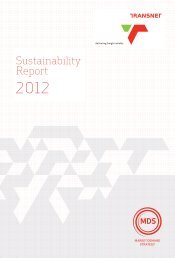Standard Operating Procedures for Container Terminals ... - Transnet
Standard Operating Procedures for Container Terminals ... - Transnet
Standard Operating Procedures for Container Terminals ... - Transnet
You also want an ePaper? Increase the reach of your titles
YUMPU automatically turns print PDFs into web optimized ePapers that Google loves.
and/or at more than one suitable berth. In such event, the Customer must pay<br />
shifting costs and the cost of relocating containers within the Terminal to the<br />
correct area of the Terminal.<br />
5.4. The Customer must provide all containers with proper markings consisting of<br />
four (4) alpha characters and seven (7) numeric characters of which the last<br />
digit will be a check digit as determined by the standard modulus check <strong>for</strong><br />
containers and which comply fully with accepted industry safety standards and<br />
international and local government regulations. The Customer alone is<br />
responsible <strong>for</strong> the accuracy of the marked capacity and <strong>for</strong> tare, gross and net<br />
weights appearing on, or declared <strong>for</strong> all, inbound containers discharged by the<br />
Terminal Operator. The Customer must ensure that the gross mass of the<br />
cargo packed into the container does not exceed the authorised gross mass <strong>for</strong><br />
that container as defined by the International Convention <strong>for</strong> Safe <strong>Container</strong>s<br />
(“CSC”) plate rating attached to the container.<br />
5.5. The Terminal Operator may in its sole discretion, refuse to handle out-of-gauge<br />
or abnormal containers which do not comply with the standards or specifications<br />
of the International <strong>Standard</strong>s Organisation, or which are over-height and overlength.<br />
5.6. Should the Terminal Operator agree to handle any containers as contemplated<br />
in Clause 5.5 above it does so without accepting or incurring any liability to any<br />
party <strong>for</strong> any loss of or damage to such containers, any cargo in or on such<br />
containers, or to any other property whatsoever except in cases of negligence<br />
or wilful misconduct. The Customer hereby indemnifies and agrees to hold the<br />
Terminal Operator harmless against any claims of whatever nature, arising from<br />
or attributable to the handling by the Terminal Operator of such containers.<br />
5.7. In the case of container operations other than those to, from and within cellular<br />
hatches, including hatches wherein the cell-guides are not in continuous smooth<br />
and uninterrupted lines, and in those cellular spaces where the lack of tolerance<br />
prohibits the normal operation of spreaders, whether the vessel be slightly listed<br />
at the time of operation, the Terminal Operator accepts no responsibility or<br />
liability <strong>for</strong> any damage occasioned and furthermore will hold the Customer<br />
responsible <strong>for</strong> any damage to container cranes, wires and spreaders thereof.<br />
The Customer must be consulted be<strong>for</strong>e container operations such as those<br />
referred to in this Clause 5.7 take place.<br />
5.8. The Customer must ensure that the stowage of the vessel is planned in such a<br />
manner as to allow the Terminal Operator to work with not less than two (2)<br />
gantry cranes at all times on an interchange of up to five hundred (500)<br />
container moves, three (3) gantry cranes at all times on an interchange between<br />
five hundred (500) and one thousand (1000) container moves and four (4)<br />
SOPCT 01/04/2013 – 31/03/2014<br />
TRANSNET PORT TERMINALS, A DIVISION OF TRANSNET SOC Ltd Page 28 of 54

















